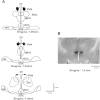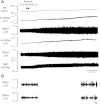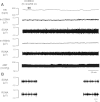Role of small conductance calcium-activated potassium channels expressed in PVN in regulating sympathetic nerve activity and arterial blood pressure in rats
- PMID: 22647293
- PMCID: PMC3423990
- DOI: 10.1152/ajpregu.00114.2012
Role of small conductance calcium-activated potassium channels expressed in PVN in regulating sympathetic nerve activity and arterial blood pressure in rats
Abstract
Small conductance Ca(2+)-activated K(+) (SK) channels regulate membrane properties of rostral ventrolateral medulla (RVLM) projecting hypothalamic paraventricular nucleus (PVN) neurons and inhibition of SK channels increases in vitro excitability. Here, we determined in vivo the role of PVN SK channels in regulating sympathetic nerve activity (SNA) and mean arterial pressure (MAP). In anesthetized rats, bilateral PVN microinjection of SK channel blocker with peptide apamin (0, 0.125, 1.25, 3.75, 12.5, and 25 pmol) increased splanchnic SNA (SSNA), renal SNA (RSNA), MAP, and heart rate (HR) in a dose-dependent manner. Maximum increases in SSNA, RSNA, MAP, and HR elicited by apamin (12.5 pmol, n = 7) were 330 ± 40% (P < 0.01), 271 ± 40% (P < 0.01), 29 ± 4 mmHg (P < 0.01), and 34 ± 9 beats/min (P < 0.01), respectively. PVN injection of the nonpeptide SK channel blocker UCL1684 (250 pmol, n = 7) significantly increased SSNA (P < 0.05), RSNA (P < 0.05), MAP (P < 0.05), and HR (P < 0.05). Neither apamin injected outside the PVN (12.5 pmol, n = 6) nor peripheral administration of the same dose of apamin (12.5 pmol, n = 5) evoked any significant changes in the recorded variables. PVN-injected SK channel enhancer 5,6-dichloro-1-ethyl-1,3-dihydro-2H-benzimidazol-2-one (DCEBIO, 5 nmol, n = 4) or N-cyclohexyl-N-[2-(3,5-dimethyl-pyrazol-1-yl)-6-methyl-4-pyrimidin]amine (CyPPA, 5 nmol, n = 6) did not significantly alter the SSNA, RSNA, MAP, and HR. Western blot and RT-PCR analysis of punched PVN tissue showed abundant expression of SK1-3 channels. We conclude that SK channels expressed in the PVN play an important role in the regulation of sympathetic outflow and cardiovascular function.
Figures








Similar articles
-
Sympathoexcitation in ANG II-salt hypertension involves reduced SK channel function in the hypothalamic paraventricular nucleus.Am J Physiol Heart Circ Physiol. 2015 Jun 15;308(12):H1547-55. doi: 10.1152/ajpheart.00832.2014. Epub 2015 Apr 10. Am J Physiol Heart Circ Physiol. 2015. PMID: 25862832 Free PMC article.
-
Excitability of paraventricular nucleus neurones that project to the rostral ventrolateral medulla is regulated by small-conductance Ca2+-activated K+ channels.J Physiol. 2009 Sep 1;587(Pt 17):4235-47. doi: 10.1113/jphysiol.2009.175364. Epub 2009 Jul 6. J Physiol. 2009. PMID: 19581379 Free PMC article.
-
Hypertension induced by angiotensin II and a high salt diet involves reduced SK current and increased excitability of RVLM projecting PVN neurons.J Neurophysiol. 2010 Nov;104(5):2329-37. doi: 10.1152/jn.01013.2009. Epub 2010 Aug 18. J Neurophysiol. 2010. PMID: 20719931 Free PMC article.
-
Small-conductance Ca2+-activated K+ channels: form and function.Annu Rev Physiol. 2012;74:245-69. doi: 10.1146/annurev-physiol-020911-153336. Epub 2011 Sep 19. Annu Rev Physiol. 2012. PMID: 21942705 Review.
-
The regulation of the small-conductance calcium-activated potassium current and the mechanisms of sex dimorphism in J wave syndrome.Pflugers Arch. 2021 Mar;473(3):491-506. doi: 10.1007/s00424-020-02500-3. Epub 2021 Jan 7. Pflugers Arch. 2021. PMID: 33411079 Free PMC article. Review.
Cited by
-
High Salt Intake Augments Excitability of PVN Neurons in Rats: Role of the Endoplasmic Reticulum Ca2+ Store.Front Neurosci. 2017 Apr 6;11:182. doi: 10.3389/fnins.2017.00182. eCollection 2017. Front Neurosci. 2017. PMID: 28428739 Free PMC article.
-
Paradoxical Excitatory Impact of SK Channels on Dendritic Excitability.J Neurosci. 2019 Oct 2;39(40):7826-7839. doi: 10.1523/JNEUROSCI.0105-19.2019. Epub 2019 Aug 16. J Neurosci. 2019. PMID: 31420457 Free PMC article.
-
Ion Channels in the Paraventricular Hypothalamic Nucleus (PVN); Emerging Diversity and Functional Roles.Front Physiol. 2018 Jul 6;9:760. doi: 10.3389/fphys.2018.00760. eCollection 2018. Front Physiol. 2018. PMID: 30034342 Free PMC article. Review.
-
Preventive and Therapeutic Role of Functional Ingredients of Barley Grass for Chronic Diseases in Human Beings.Oxid Med Cell Longev. 2018 Apr 4;2018:3232080. doi: 10.1155/2018/3232080. eCollection 2018. Oxid Med Cell Longev. 2018. PMID: 29849880 Free PMC article. Review.
-
Sympathoexcitation in ANG II-salt hypertension involves reduced SK channel function in the hypothalamic paraventricular nucleus.Am J Physiol Heart Circ Physiol. 2015 Jun 15;308(12):H1547-55. doi: 10.1152/ajpheart.00832.2014. Epub 2015 Apr 10. Am J Physiol Heart Circ Physiol. 2015. PMID: 25862832 Free PMC article.
References
-
- Adelman JP, Maylie J, Sah P. Small-conductance Ca2+-activated K+ channels: form and function. Annu Rev Physiol 74: 245–269, 2012 - PubMed
-
- Bains JS, Ferguson AV. Paraventricular nucleus neurons projecting to the spinal cord receive excitatory input from the subfornical organ. Am J Physiol Regul Integr Comp Physiol 268: R625–R633, 1995 - PubMed
-
- Boudaba C, Schrader LA, Tasker JG. Physiological evidence for local excitatory synaptic circuits in the rat hypothalamus. J Neurophysiol 77: 3396–3400, 1997 - PubMed
Publication types
MeSH terms
Substances
LinkOut - more resources
Full Text Sources
Molecular Biology Databases
Research Materials
Miscellaneous

